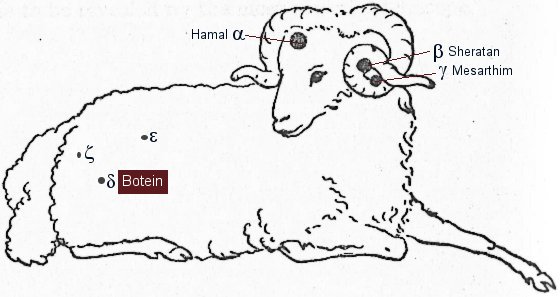| Fixed star: BOTEIN | |
| Constellation: Delta (δ) Aries | |
| Longitude 1900: 19TAU27 | Longitude 2000: 20TAU51 |
| Declination 1900: +19.21′ | Declination 2000: +19.44′ |
| Right ascension: 03h 11m | Latitude: +01.49′ |
| Spectral class: K2 | Magnitude: 4.5 |
The history of the star: Botein
from p.83 of Star Names, Richard Hinckley Allen, 1889.
[A scanned copy can be viewed on this webpage

Botein is from Al Butain, the dual of Al Batn, the Belly, probably from some early figuring, for in modern maps the star lies on the tail. [On the Flamsteed’s drawing of Aries delta is positioned on the outstretched tail]
With zeta (ζ) it was Tsin Yin in China.
Delta (δ), epsilon (ε) and rho (ρ) generally were considered the 28th manzil (Arabic Moon Mansion), Al Butain, but the Persian astronomer Al Biruni (973-1048 A.D.) substituted pi for rho (ρ), and others, zeta (ζ); while still others located this station in our Musca (an extinct constellation, Musca Borealis; now part of Aries), the faint little triangle above the figure of the Ram.
Star Names, Their Lore and Meaning, Richard Hinckley Allen, 1889].
The Lunar Mansions
Delta (δ Botein), with the unnamed stars epsilon (ε) and rho (ρ) Aries were generally considered the 28th manzil (Arabic Moon Mansion), Al Butain
Influences of the 28th Arabic manzil, Al Butain: Helps the finding of treasures and retaining of captives. [Robson, p.75.]
With Moon transiting here: buy and sell but avoid the sea. [Robson, p.75.]
The astrological influences of the constellation Aries
Legend: Aries represents the ram with the golden fleece, a gift from Mercury, upon which Phrixus and his sister Helle escaped through the air from their step-mother Ino. On arriving in Colchis, Phrixus sacrificed the ram to Jupiter and its fleece was hung in the Grove of Mars, whence it was subsequently carried away by Jason (see Argo). According to another account it was the ram that guided Bacchus to a spring of water in the Libyan desert. [Robson, p.31.]
Influences: Ptolemy’s observations are as follows: "The stars in the head of Aries possess an influence similar in its effects to that of Mars and Saturn: those in the mouth act similarly to Mercury, and in some degree to Saturn; those in the hinder foot, to Mars; those in the tail, to Venus." By the Kabalists Aries is associated with the Hebrew letter He and the 5th Tarot Trump "The Pope." [Robson, p.31.]
"All the Aries stars have been in the sign Taurus for 200-300 years now. Hamal just over 600, (Botein year 505AD) and in this same period we have seen large-scale aggression change its nature from barbaric raiding and migration of earlier centuries to the building of large empires which had to be administered and kept in peace and good order, as well as exploited by their conquerors. This is typical both of the sign Taurus and of the planet Saturn". [The Living Stars, Dr. Eric Morse, p.33.].
The astrological influences of the constellation Aries given by Manilius:
"The Ram, who is rich with an abundance of fleecy wool and, when shorn of this, with a fresh supply, will ever cherish hopes; he will rise from the sudden shipwreck of his affairs to abundant wealth only to meet with a fall, and his desires will lead him to disaster; he will yield his produce for the common benefit, the fleece which by a thousand crafts gives birth to different forms of gain, now workers pile into heaps the undressed wool, now card it, now draw it into a tenuous thread, now weave the threads to form webs, and now they buy and sell for gain garments of every kind; no nation could dispense with these, even without indulgence in luxury. So important is this work that Pallas herself has claimed it for her own hands, of which she has judged it worthy, and deems her victory over Arachne a token of her greatness. These are the callings and allied crafts that the Ram will decree for those born under his sign: in an anxious breast he will fashion a diffident heart that ever yearns to commend itself by its own praise.
"When the Ram emerges above the surface of the waves (rising) and the curve of his neck appears before his horns, he will give birth to hearts that are never content with what is theirs; he will engender minds bent on plunder and will banish all sense of shame: such is their desire for venture. Even thus does the ram himself rush forth with lowered horns, resolved to win or die. Not for them the gentle ease of a fixed abode with none but peaceful cares; it is ever their delight to travel through unknown cities, to explore uncharted seas, and enjoy the whole world’s hospitality. The Ram himself gives you evidence of this: once furrowing a trail through the glassy sea, he tinged it with the gold of his fleece, when on his back he carried Phrixus, bereft of his sister (Helle) by fate’s decree, and brought him to the banks of the Phasis and to Colchis". [Astronomica, Manilius, 1st century AD, book 4, p.233].
References:
Fixed Stars and Constellations in Astrology, Vivian E. Robson, 1923].